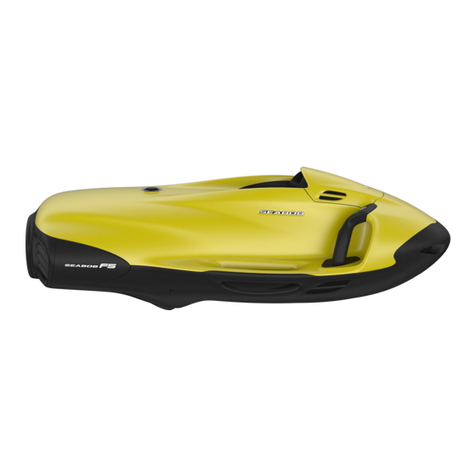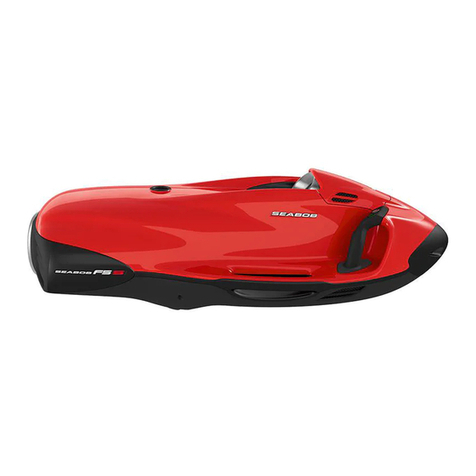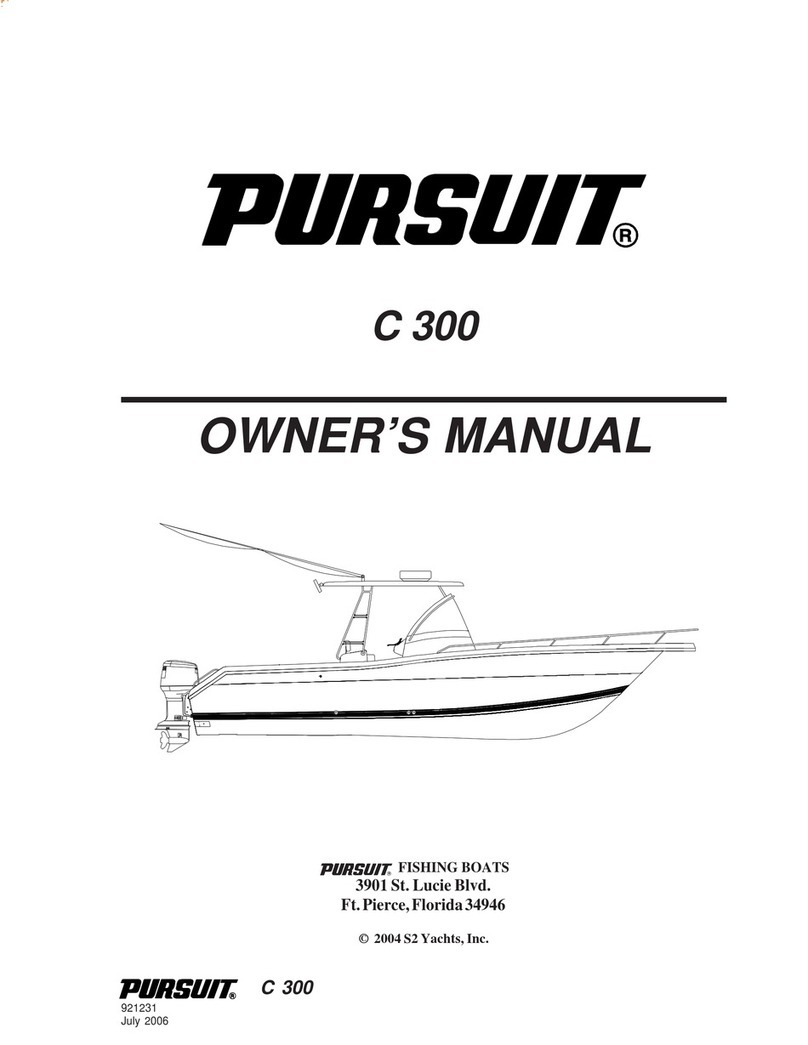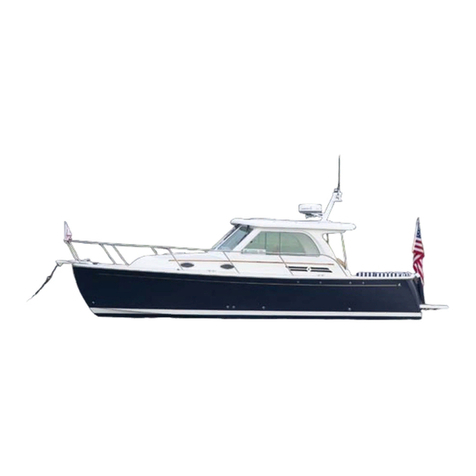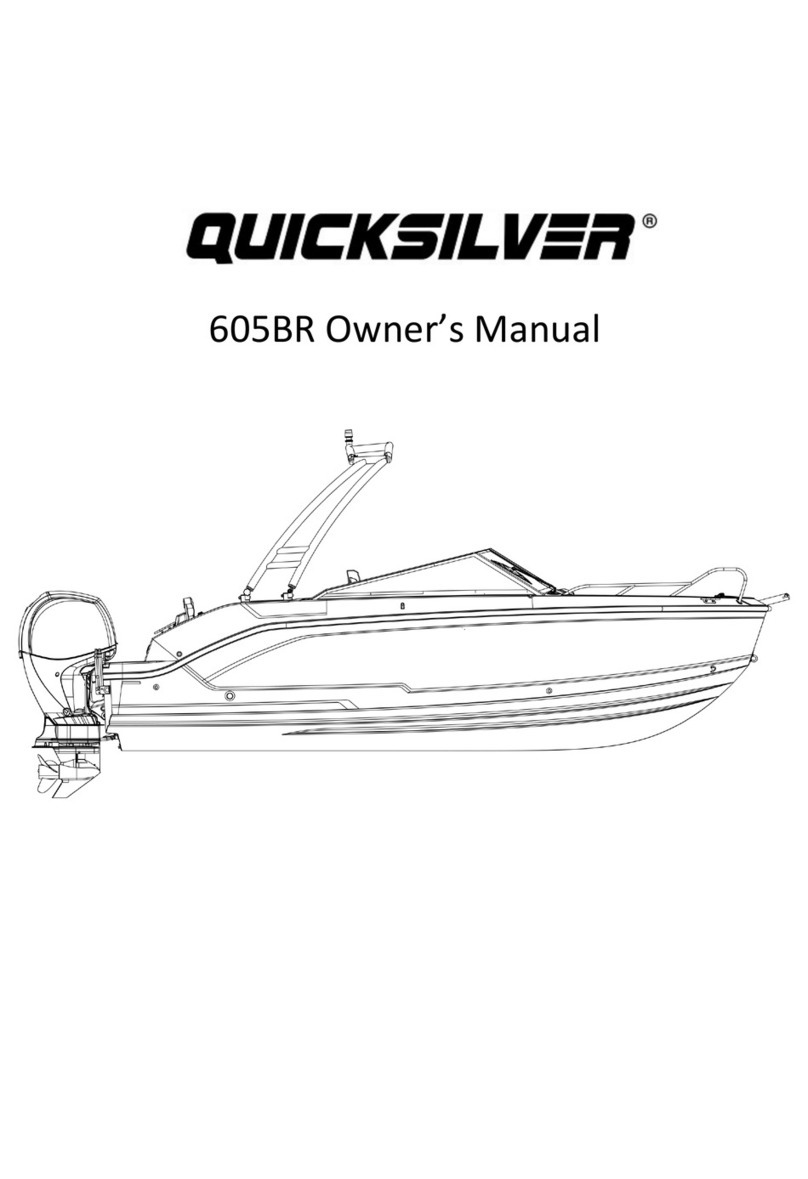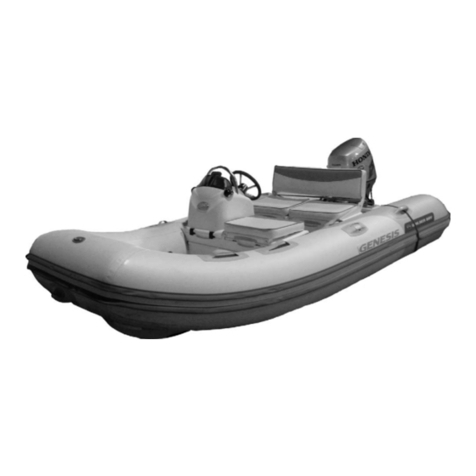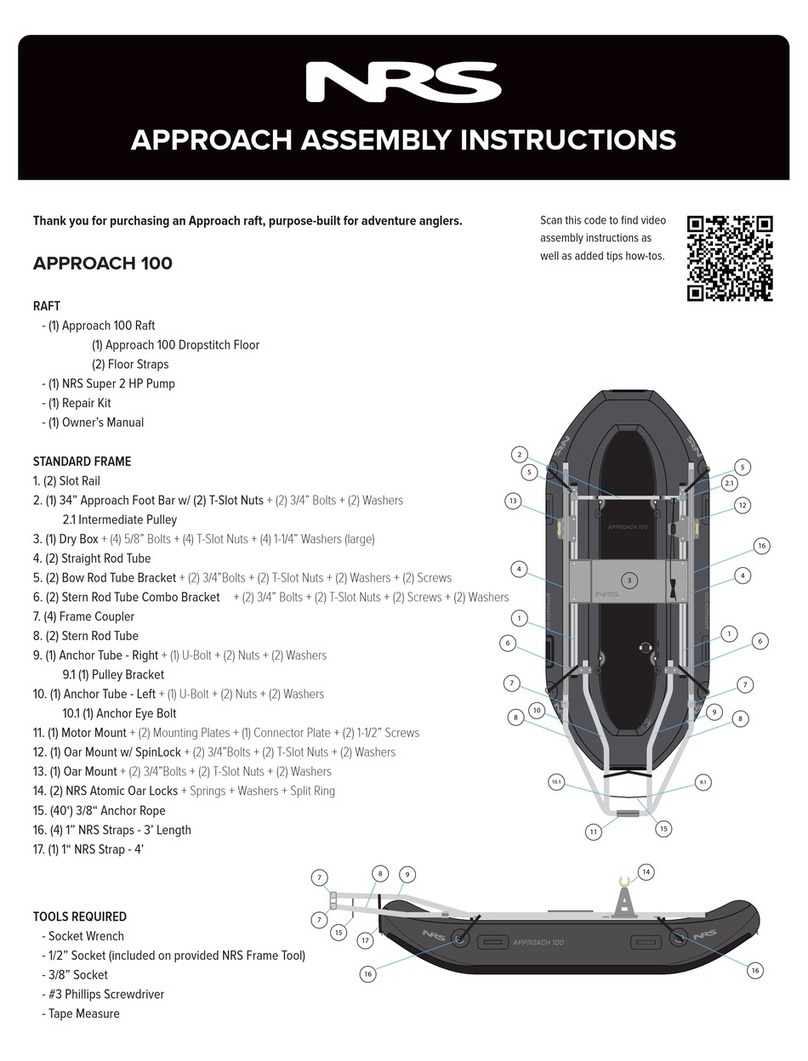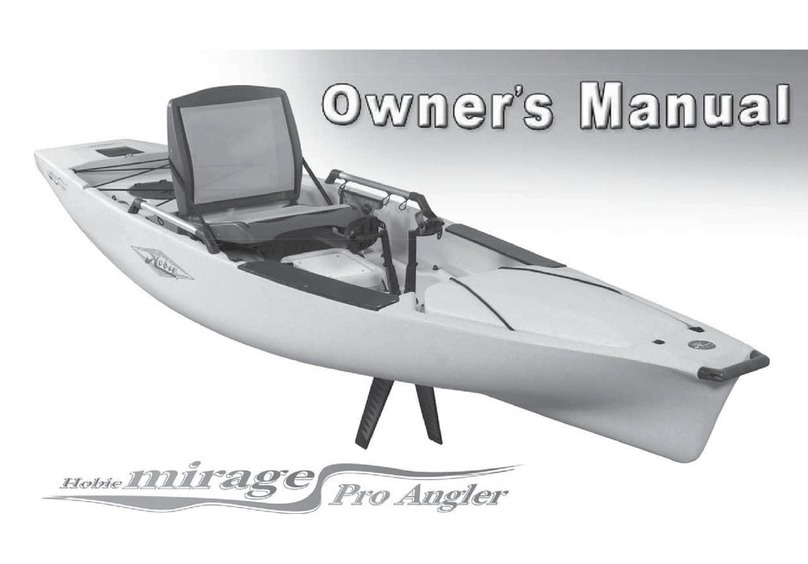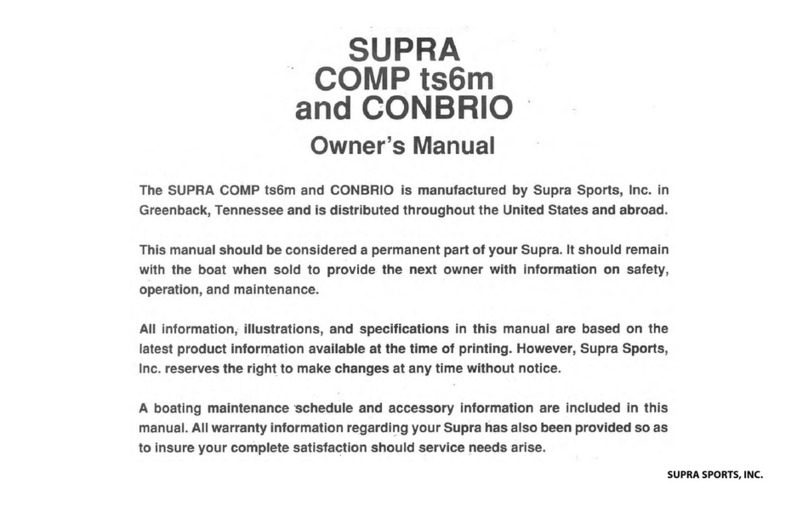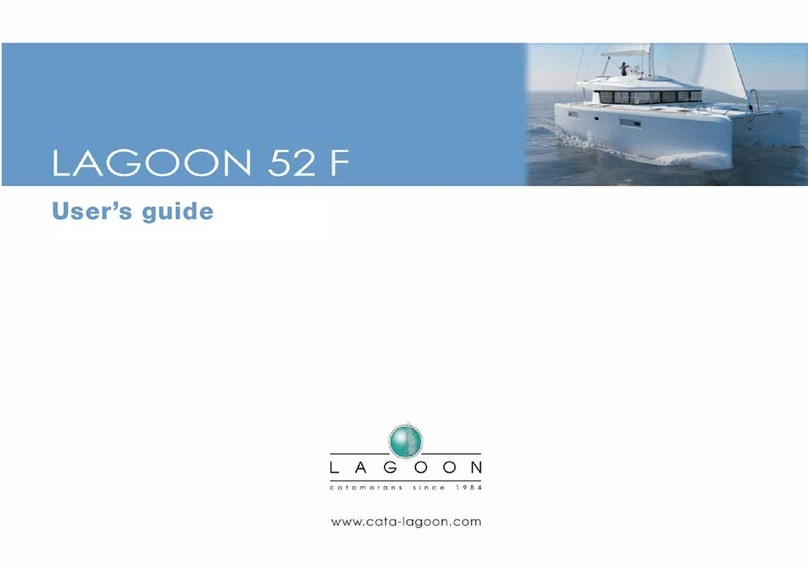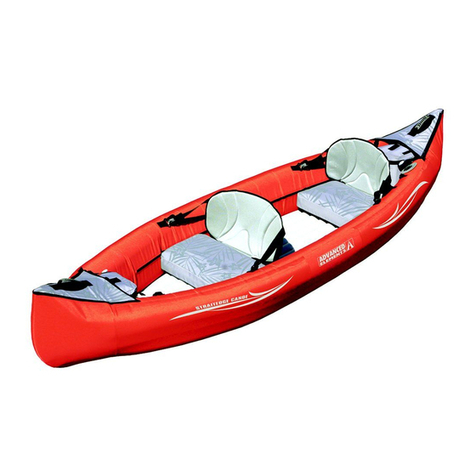SEABOB RAVEJET User manual

Operation Manual
SEABOB RAVEJET
SEABOB JET 4.12
SEABOB CAYAGO VX2
SEABOB CAYAGO F7
English


Introduction
Congratulations on the purchase of your new SEABOB! The SEABOB is an innovative water-sports craft that allows
you to move through water virtually silently and ecologically friendly without producing emissions. In developing the
SEABOB, special attention has been given to hydrodynamics and ergonomic handling. The SEABOB impresses with its
exclusive design coupled with high performance and advanced technology.
Like all watercraft, the SEABOB requires that operators take specific precautions when using it. For this reason, we
urge you to read through the Operation Manual carefully – in particular, the safety information and the instructions
on proper use – before operating the SEABOB.
So get ready to dive into a fascinating new world! We wish you many hours of fun with your SEABOB!
The following symbols are used in this Operation Manual to bring your attention to important information:
Caution! Danger of injury and / or death. This symbol indicates that operating the SEABOB involves the risk of
injury to, or death of the operator or other persons.
Not heeding this information may result in damage to or destruction of the SEABOB or other property.
Note: Notes provide you with important operating information or other information that can help you to understand
the operation of the SEABOB better.
CAYAGO AG constantly works to optimise its products to keep pace with the advance of technology. As a result,
CAYAGO AG reserves the right to change or modify the product characteristics specified in this Operation Manual at
any time without prior notice. Characteristics and functions described and illustrated in this Operation Manual may
differ from the actual characteristics and functions of the product.
SEABOB is a registered trademark.

| Page 4 | SEABOB Operation Manual |
Contents
1. Safety information .................................................................................................................................... 6
1.1 Special safety information ................................................................................................................................... 7
1.2 General safety information .................................................................................................................................. 9
1.3 Safety information for diving to a depth of up to 2.5 m .................................................................................... 14
1.4 Safety information for diving to a depth of more than 2.5 m ............................................................................ 15
1.5 Safety information concerning the accumulator box ......................................................................................... 17
1.6 Safety information concerning the SEABOB CAYAGO F7 model ........................................................................ 19
2. Proper use ............................................................................................................................................... 20
2.1 Operation on the water surface ......................................................................................................................... 20
2.2 Diving ................................................................................................................................................................ 22
3. Included in delivery ................................................................................................................................. 23
4. Description of the device ........................................................................................................................ 24
4.1 SEABOB housing (SEABOB RAVEJET and SEABOB JET 4.12 models) ................................................................. 24
4.2 SEABOB ACS housing (SEABOB CAYAGO VX2 and SEABOB CAYAGO F7 models) ................................... 25
4.3 Accumulator box ACS (ACS = Accumulator Change System) .................................................................. 26
4.4 Right Controlgrip ............................................................................................................................................... 26
4.5 Left Controlgrip ................................................................................................................................................. 27
4.6 Drive unit ........................................................................................................................................................... 27
5. Operation ................................................................................................................................................. 28
5.1 Start-up ............................................................................................................................................................. 28
5.2 Charging the accumulator box .......................................................................................................................... 28
5.3 Installing the accumulator box ACS (Accumulator Change System) ...................................................... 32
5.4 Operating the SEABOB ...................................................................................................................................... 35
5.4.1 Controls and display panel .......................................................................................................................... 35
5.4.2 Arrangement of the controls ........................................................................................................................ 36
5.4.3 Using the controls ........................................................................................................................................ 36
5.4.4 Display (operation display) .......................................................................................................................... 37
5.4.5 Off mode (air transport / storage) – switching on / off ................................................................................ 38
5.4.6 Sleep mode – switching on / off .................................................................................................................. 39
5.4.7 Stand-by mode ............................................................................................................................................ 40
5.4.8 On mode ...................................................................................................................................................... 41
5.4.9 Charge mode ............................................................................................................................................... 41
5.4.10 Charge display ........................................................................................................................................... 42
5.4.11 Displaying serial numbers .......................................................................................................................... 43
5.4.12 Entering PIN (Owner-PIN / User-PIN) ......................................................................................................... 43
5.4.13 Settings ...................................................................................................................................................... 44
5.4.14 Operation ................................................................................................................................................... 45
5.4.15 IrDA (infrared interface) ............................................................................................................................. 45

| Page 5 | SEABOB Operation Manual | 2410 37 611 513 12 9 8 1
5.5 Before starting ................................................................................................................................................... 46
5.6 Operation on the water surface ......................................................................................................................... 47
5.6.1 How to navigate your SEABOB .................................................................................................................... 47
5.6.2 Accumulator box charge state and emergency reserve ................................................................................ 49
5.7 Diving to a depth of up to 2.5 m ....................................................................................................................... 50
5.7.1 How to dive with your SEABOB ................................................................................................................... 50
5.8 Diving to a depth of more than 2.5 m ............................................................................................................... 51
5.8.1 Setting the maximum diving depth .............................................................................................................. 51
5.8.2 Adjusting the buoyancy of the SEABOB ....................................................................................................... 52
5.9 After use ............................................................................................................................................................ 53
5.10 Switching off the SEABOB to Sleep mode ....................................................................................................... 54
5.11 Detaching the accumulator box ACS (Accumulator Change System) ................................................... 54
5.12 Storing the SEABOB and accumulator box ACS .................................................................................... 55
5.13 Air transport / transport of the SEABOB and accumulator box ACS ...................................................... 57
5.14 Switching off the SEABOB for storage or transport ......................................................................................... 58
6. Care ......................................................................................................................................................... 59
6.1 Cleaning the SEABOB, accumulator box and charger ........................................................................................ 59
6.2 Changing the seals ............................................................................................................................................ 60
7. Troubleshooting ....................................................................................................................................... 62
7.1 SEABOB cannot be switched on ........................................................................................................................ 62
7.2 Accumulator box emits an acoustic signal .......................................................................................................... 63
7.3 Motor does not run ........................................................................................................................................... 63
7.4 Impeller does not turn (no thrust) ..................................................................................................................... 64
7.5 Stator / impeller blades are bent or broken (low thrust or no thrust at all) ....................................................... 65
7.6 Powergrip does not function properly ............................................................................................................... 68
7.7 Display does not show entire image .................................................................................................................. 68
7.8 Moisture present on high-current connecting plates (on models with Accumulator Change System) ... 69
7.9 Moisture present in charging socket ................................................................................................................. 69
8. Technical specifications ........................................................................................................................... 70
9. Disposal ................................................................................................................................................... 75
10. Replacement parts ................................................................................................................................. 76
11. Accessories ............................................................................................................................................ 77
12. Service ................................................................................................................................................... 78
13. Imprint ................................................................................................................................................... 79
These chapters only relate to the SEABOB CAYAGO VX2 and SEABOB CAYAGO F7 models with Accumulator
Change System (ACS).

| Page 6 | SEABOB Operation Manual | 1
Caution! Please read the following information!
1. Safety information
The SEABOB is a state-of-the-art device. It conforms to current standards and is safe to operate. Nevertheless, us-
ing the device in an unintended fashion or not heeding the safety information may cause injury to, or death of the
operator and / or other persons. In addition, the SEABOB and other property of the operator or other persons may be
damaged or destroyed.
For this reason, we urge you to read the Operation Manual and the safety information contained in the Manual care-
fully before you operate your SEABOB for the first time. The information contained in the Operation Manual will help
you to operate the SEABOB safely, protect yourself and others from hazards, and prevent damage to the device and
other property.
Keep this Operation Manual in a safe and easily accessible place for reference whenever needed. Please do not throw
away the packaging. It can be used later to provide optimum protection for the device (for example, when sending
the device in for service).

| Page 7 | SEABOB Operation Manual | 1
1.1 Special safety information
Please pay particular attention to the very important safety information below! This information is also
provided on safety labels that are directly attached to the SEABOB, accumulator box and charger for easy
reference:
Special safety information on the SEABOB
• Important! Observe Operation Manual!
• Suitable only for swimmers aged 16 or older!
• Do not use as swimming aid!
• Wear life jacket when away from shore or boat!
• Wear body-hugging clothing (without loose straps or bands)!
• Wear bathing cap or hair net if hair is shoulder length or longer!
• Do not reach into openings (jet channel)! Rotating parts!
• Use only in sheltered waters!
• Do not use in strong currents, heavy swell or impaired visibility!
• Do not use in areas occupied by swimmers or divers!
• Maintain distance (minimum 5 m) to other persons and objects!
• Always observe accumulator charge state and return to shore in time!
• Do not store in sunlight or closed motor vehicle!
Special safety information on the accumulator box
• Important! Observe Operation Manual!
• Do not heat beyond 60 °C / 140 °F!
• Do not store in sunlight or closed motor vehicle!
• Do not short circuit!
• Do not open!
• Do not puncture!
• Do not knock!
• Do not burn!
• Use only chargers supplied by SEABOB manufacturer!
• Charge only in dry locations! Never detach accumulator box ACS in water!
• Never transport fully charged accumulator box by aircraft or over long distances!
• Observe instructions on charging, discharging, storage and transport!
• If instructions are ignored, flaming gases can be discharged through safety valve
causing serious injury!

| Page 8 | SEABOB Operation Manual | 1
Special safety information on charger
• Important! Observe Operation Manual!
• Do not expose to direct sunlight! Do not open!
• Use only with clean and dry plug connections!
• Never use if cables or plugs are damaged!
• Charge only in dry, cool and well ventilated locations!
• Do not cover! Ensure free air circulation!
• Heats up during charging process! Allow to cool before handling!
Never expose the SEABOB, accumulator box and charger to high temperatures (max. 60 °C / 140 °F) caused
e.g. by open fire, direct sunlight or by storage inside a closed motor vehicle or boot. If exposed to heat, flaming
gases can be discharged through the accumulator cells‘ safety valve causing serious injury. In addition, the LCD display
will turn black if exposed to heat and may become irreparably damaged.
Never transport a fully charged accumulator box by aircraft or over long distances. The accumulator box should
only be partially charged during transport (charge state "air transport / storage"). Only switch off the SEABOB
for transport when the aircraft symbol is displayed. If instructions are disregarded, flaming gases can be discharged
through the safety valve causing serious injury!

| Page 9 | SEABOB Operation Manual | 1
1.2 General safety information
General safety information concerning the user
• Only skilled and experienced swimmers aged 16 and older are allowed to use the
SEABOB.
• Due to the high power output of the device, children and young people under
16 years of age should not be permitted to operate the SEABOB. As with all
motor vehicles, persons operating the device must do so responsibly and with
proper foresight.
• Use of the SEABOB by persons with pacemakers is not permitted. The strong
magnetic fields created by the motor and current-carrying cables may cause se-
vere damage to pacemakers, resulting in possible death.
• Use of the SEABOB by pregnant women is not permitted. During operation, the
SEABOB may press up against the abdomen of pregnant women and / or the jet
of water coming out of the device may come into contact with the abdomen.
• Never use the SEABOB while under the influence of alcohol, medication or drugs.
Persons using the SEABOB must be able to react quickly. Alcohol, medication and
drugs can considerably inhibit the ability of persons using the device to react
quickly.
• Use the SEABOB only if you are completely healthy. Diving even if you only have
a light head cold may cause problems when you try to equalise the pressure in
your ears.
• Only wear body-hugging clothing (without loose straps or bands) when using the
device. Wear a bathing cap or hair net if your hair is shoulder length or longer. The
device is equipped with the smallest protective lamellas possible. Nevertheless,
it is technically impossible to fully prevent objects, in particular pieces of cloth-
ing, thin cords or shoulder-length hair, from entering the jet channel and getting
wrapped around the drive shaft due to the extremely high suction power of the
jet drive. Should this occur, there is a risk of injury.
• Wear a life jacket when you are away from the shore or boat. Do not stray too
far from the shore or the accompanying boat. Maintain a distance that is short
enough, so that you can swim back by yourself in case of emergency. Be aware
of any currents in the area that could carry you away.
• For better visibility, wear diving goggles. Attention! Despite every precaution
taken, it is still possible for diving goggles to come off during operation of the
SEABOB and for contact lenses to be lost.
• Water spraying against and over your body can not only be strenuous, but also
takes away body heat. We recommend wearing a diving suit that provides ad-
equate warmth.

| Page 10 | SEABOB Operation Manual | 1
General safety information concerning the SEABOB
• Never reach into the jet channel where the impeller is rotating. The closely fitted
protective lamellas with their special, hydrodynamically optimised profile allow
water to enter and exit the device without any obstructions. Always keep an
eye on persons – especially children and young people – who are close to the
SEABOB to ensure that they do not attempt to reach into the jet channel.
• Check that the jet channel cover is not damaged in any way and is attached cor-
rectly and firmly in position. Never remove the protective lamellas. Caution! The
rotating impeller may cause injury.
• Make sure that no sand, dirt, stones, rope or other foreign objects get into the jet
channel. Never remove foreign objects from the jet channel while the SEABOB is
in the water. Danger of injury!
• Only remove the jet channel cover after you have completely switched off the
SEABOB (Off mode). On models with the Accumulator Change System (ACS), first
detach and remove the accumulator box ACS from the SEABOB. Caution! The
impeller may be rotating. Contact with the impeller when it is rotating can cause
serious injuries.
• Never place any objects into the jet channel by hand. Doing so can cause injury.
• Never leave the SEABOB unattended to prevent children or other inexperienced
persons from using it. Switch off the SEABOB after use (Sleep mode).
• The SEABOB is a heavy device. Ensure that the SEABOB does not fall on you or
other persons in the water or on land. Should this occur, there is a risk of injury.
• Always place the SEABOB, accumulator box and charger in the shade. It is im-
portant to remember that the SEABOB, accumulator box and charger will get hot
naturally if left in the sun too long. Caution! Touching hot surfaces may cause
burns. If exposed to heat, flaming gases can be discharged through the accumu-
lator cells‘ safety valve causing serious injury! In addition, the LCD display will
turn black if exposed to heat and may become irreparably damaged.
• Moor the SEABOB safely if you decide leave it in the water for a short time. En-
sure that the SEABOB cannot become unattached, injure others or obstruct their
path.
• Never detach or remove the accumulator box ACS (Accumulator Change System)
from the SEABOB ACS while the device is in the water. Always take precautions to
prevent the high-current connecting plates on the accumulator box and SEABOB
from coming into direct contact with the water. If this occurs, a short circuit may
result, causing irreparable damage to the SEABOB‘s electronic system. Water,
especially salt water, is highly conductive of electricity. As a result, water seeping
into the accumulator box may cause flaming gases to be discharged through the
accumulator cells’ safety valve causing serious injury.

| Page 11 | SEABOB Operation Manual | 1
• Before charging the accumulator box, check that the charging socket and charg-
ing plug are perfectly clean and dry. Never open the sealing cap on the accumu-
lator box charging socket while the SEABOB is in the water. Wet and / or dirty
plug connections may cause a short circuit while the accumulator box is being
charged or even before this process is begun. If a short circuit occurs, it can cause
irreparable damage to the charging contacts of the SEABOB. Caution! Short cir-
cuits can cause fires.
• Always ensure that the Powergrip is functioning properly. When you release the
Powergrip, the SEABOB should immediately switch off. The Powergrip should be
able to move freely in all positions. When released, it should always return un-
obstructed forward to the Off position. A damaged, sticking or bent Powergrip
should be repaired or replaced immediately. If the Powergrip is not functioning
properly, you can stop the motor by tapping the red button repeatedly until the
power is displayed as "0 %".
• Never stick sharp objects into the depth sensor or do anything else that could
damage the depth sensor. Prevent all dirt, sand, polish or other material from
getting into the water inlets on the depth sensor. A damaged depth sensor or
dirty inlets can impair operation of the device, even leading to complete failure.
Always rinse out the depth sensor thoroughly with fresh water to prevent the
build-up of salt deposits. Use a garden hose or similar equipment for cleaning.
Never use a high-pressure hose or steam jet. If the depth sensor is damaged or
the inlets are dirty, the motor’s safety cut-off will not function at the set maxi-
mum diving depth (default setting 2.5 m). This may damage the health of the
user.
• Never open the SEABOB yourself. Repairs and maintenance work on the SEABOB
that go beyond the procedures described in Chapter 6 "Care" and Chapter 7
"Troubleshooting" may only be carried out by an authorised technician. Work
of this type is dangerous and may result in severe injury or cause damage to the
SEABOB if not carried out by an authorised technician.
• Never alter or modify any part of the SEABOB, accumulator box or charger. Doing
so may result in serious injury or death.
• If you detect any damage to the SEABOB, in particular to the accumulator box,
charging socket and sealing cap, or seals between the SEABOB and accumulator
box ACS (Accumulator Change System), immediately stop operating the device
and contact the manufacturer or your specialist dealer.

| Page 12 | SEABOB Operation Manual | 1
General safety information concerning operation
• SEABOB operators are not afforded any special rights with regard to operation
of the craft. Operators must act responsible and prudently, taking all precautions
that may be necessary.
• Only use the SEABOB in sheltered waters and when accompanied by others or
under the constant supervision of another person who can provide immediate
assistance in case of emergency.
• Do not operate the SEABOB in strong currents, strong wind (maximum wind
force 4), bad weather or impaired visibility. By doing so, you put yourself and
others in danger. Never use the SEABOB during a thunderstorm! Get out of the
water as quickly as possible before the storm begins. Not doing so may result in
serious injury or death. Always be prepared for a sudden change in the weather.
Always check the weather forecast before you set out, and pay close attention to
local weather conditions.
• Do not use the SEABOB in a heavy swell (significant wave heights up to 0.3 m
maximum and occasional waves of 0.5 m maximum height). The SEABOB may
seriously injure you or other persons. You can become separated from the SEA-
BOB, and / or it may be thrown with great force onto you or other persons by a
wave, particularly when in the surf.
• Hold on to the two Controlgrips on the SEABOB securely. The force of accelera-
tion can be very high, especially when starting.
• To brake, hold on to both SEABOB Controlgrips securely, and release the Pow-
ergrip in your right hand so that it can move forward. The motor will stop, and
the resistance of the water will slow you down. Be aware that it can take around
2-3 m for you to come to a complete stop if you are travelling at full speed. You
can reduce the distance it takes you to come to a complete stop by turning the
SEABOB sharply to the side and straightening up without letting go of the craft.
This helps you to maintain control of the SEABOB and increases the water re-
sistance considerably, so that you can come to a complete stop as quickly as
possible.
• If the SEABOB is released while travelling at full speed, the craft may continue
moving up to approx. 3 m and may briefly dive under the water to a depth of up
to approx. 2 m. When this occurs, there is the risk that persons may be injured
and foreign objects may be damaged. Also the SEABOB may be damaged, par-
ticularly if the water is too shallow and the craft hits the bottom.
• Do not use the SEABOB in areas occupied by swimmers or divers. Danger of col-
lision and injury! If crossing such areas is absolutely unavoidable, operate with a
maximum power of 10 % on the water surface.

| Page 13 | SEABOB Operation Manual | 1
• To prevent collisions, always maintain a safe distance (minimum 5 m) to other
swimmers, watercraft or any objects that may be in the water. A collision may
result in serious injury to you and other people. In particular, long hair or pieces
of clothing of other people can get sucked into the jet channel. Should this occur,
there is a risk of injury. In addition, the SEABOB may also be damaged consider-
ably.
• Always avoid routes travelled by watercraft. The SEABOB housing is made of
plastic and, for physical reasons, is unable to reflect radar waves adequately.
Take into account the speed at which other watercraft are approaching. Another
SEABOB may also approach quickly or appear suddenly. Keep an eye on what is
happening farther up ahead. Beware of collisions!
• The SEABOB is not equipped with lights and, for this reason, is not suitable for
operation at night. Do not operate the craft after sunset or before sunrise. Doing
so can lead to collisions with other watercraft or obstacles.
• Do not operate the craft in water that is less than 1 m deep. Doing so can cause
injury to you or damage to the SEABOB as a result of hitting underwater objects.
Stay away from the immediate shore, and never attempt to steer the SEABOB
onto the beach, shore or onto land of any kind. Be very careful of rocky bottoms,
reefs and stones.
• The operating time of the SEABOB is limited. For this reason, you should always
keep an eye on the display showing the remaining operating time, and return to
the shore or accompanying boat in time.
• When the accumulator is discharged to approx. one third of its charge state, the
maximum power is automatically reduced incrementally (80 %, 70 %, 60 % etc.)
to prolong accumulator cell life. The device begins using the emergency reserve
of the accumulator box after the warning symbol appears on the upper left-hand
side of the display, the accumulator symbol starts flashing and the remaining
operating time is shown as "0:00". The estimated remaining operating time in
emergency mode is approx. 5 minutes, with a continual reduction in power until
the motor has stopped. Always take into account the limited power when timing
your return to the shore or boat.
• In most instances, the general personal liability insurance of the user does not
cover property damage caused by the use of SEABOB. Before using the SEABOB
you are encouraged to contact your insurance provider for information on a suit-
able insurance policy for coverage in cases involving damage.

| Page 14 | SEABOB Operation Manual | 1
1.3 Safety information for diving to a depth of up to 2.5 m
In addition to the safety information provided above, be sure to observe the following information when
diving to a depth of up to 2.5 m:
• Only skilled and experienced swimmers should be allowed to use the SEABOB for
diving to a depth of up to 2.5 m.
• Only use the SEABOB for diving if you are completely healthy. Consult a doctor if
you are in doubt.
• Never dive alone.
• Be aware that it is very difficult to judge the distance of objects under water. For
better visibility, wear diving goggles.
• Before diving, always check to make sure that the depth sensor is working prop-
erly. If the depth sensor is damaged or the water inlets are dirty, the motor’s
safety cut-off will not function at the set maximum diving depth (default setting
2.5 m). When the SEABOB is switched on, the depth sensor is automatically reset
to "0.0 m". For this reason, you should switch on the SEABOB only when the
craft is close to or at the same level of the surface of the water.
• Maintain a safe distance (minimum 5 m) to other persons and objects. Never at-
tempt to dive under other swimmers, watercraft or through underwater objects.
Before resurfacing, ensure that there are no swimmers, watercraft or objects
above you or approaching you. Danger of collision!
• Respect the environment. Maintain a safe distance to the bottom of the sea or
lake, so that sediment or aquatic plants are not kicked up and damaged by the
jet of water coming from the craft or get into the jet channel. Steer clear of rocky
bottoms, reefs and stones, which can lead to injury.
• Always keep an eye on the remaining operating time shown on the display, and
make sure you resurface in time. Leave enough operating time so that you can
get back, and make sure that you start making your way back to the accompany-
ing boat or shore in time.
• When calculating the time it will take you to return, be sure to take into account
the limited power of the craft in emergency mode.

| Page 15 | SEABOB Operation Manual | 1
1.4 Safety information for diving to a depth of more than 2.5 m
In addition to the safety information provided above, be sure to observe the following information when
diving to a depth of more than 2.5 m:
• Only divers with a valid diving licence or accompanied by a certified diving in-
structor are allowed to use SEABOB for diving to a depth of more than 2.5 m.
• Only use the SEABOB for diving if you are completely healthy. Consult a doctor if
you are in doubt.
• Never dive alone. Especially when scuba diving in caves, make sure that you are
accompanied by another person with a second craft.
• Use only complete and fully functional diving equipment when diving. Ensure
that no air apparatus components or hoses are hanging free in the water where
they might get into the jet channel.
• Only dive when the visibility under water is good. Never dive without diving gog-
gles. Only with diving goggles will you be able to detect underwater hazards in
time.
• Before diving, always check to make sure that the depth sensor is working prop-
erly. If the depth sensor is damaged or the water inlets are dirty, the motor’s
safety cut-off will not function at the set maximum diving depth (default setting
2.5 m). The depth sensor reading in the display should be approx. "0.0 m" when
the craft is on the water surface. You can double-check the reading by briefly
submerging the SEABOB without activating the motor.
• The motor cuts off automatically if the set maximum diving depth (depth limit)
is exceeded and can only be switched back on when the craft has returned to a
diving depth that is above the depth limit.
• For safety reasons, the factory-set depth limit of 2.5 m can only be changed by
first entering your Owner-PIN. This is done to prevent the setting of the maxi-
mum diving depth from being changed by unauthorised persons. After you have
finished scuba diving to a depth of more than 2.5 m, reset the maximum diving
depth immediately to the default safety setting of 2.5 m to prevent the risk of
injury to others.
• For safety reasons, the depth limit is automatically reset to the default setting of
2.5 m each time the SEABOB is switched on.
• Keep in mind that the SEABOB switches off automatically (Sleep mode) if inac-
tive for an extended period of more than 10 minutes (Time-off). After switching
the SEABOB back on, you will need to re-enter your Owner-PIN if you want to
start the motor at a diving depth of more than approx. 2.5 m. After entering your
Owner-PIN, you can increase the depth limit again so that the set maximum div-
ing depth is greater than the one currently shown. The diving depth display and
the warning symbol will start flashing as soon as you exceed the depth limit.

| Page 16 | SEABOB Operation Manual | 1
• When scuba diving, never rely completely on the depth sensor reading. The depth
sensor is provided for information purposes only. The depth sensor is not a cali-
brated gauge and should not be used to perform tasks such as calculating de-
compression times.
• Always keep an eye on the remaining operating time shown on the display. When
the accumulator is discharged to approx. one third of its charge state, the maxi-
mum power is automatically reduced incrementally (80 %, 70 %, 60 % etc.) to
prolong accumulator cell life. The device begins using the emergency reserve of
the accumulator box after the warning symbol appears on the upper left-hand
side of the display, the accumulator symbol starts flashing and the remaining
operating time is shown as "0:00". The estimated remaining operating time in
emergency mode is approx. 5 minutes, with a continual reduction in power until
the motor has stopped. Always take into account the limited power when timing
your ascent to the surface and your return to the shore or boat.
• You must always ensure that you are able to resurface and return to the shore or
boat by yourself without the assistance of the SEABOB.
• Regardless of whether you are using the SEABOB while scuba diving, you should
always adhere to the recommended descent and ascent rates and maximum div-
ing duration in line with applicable diving association guidelines. Always check
the display showing the remaining operating time of the SEABOB. For your own
safety, however, we urge you to avoid relying solely on the craft‘s equipment.
Never use the depth sensor to calculate descent or ascent rates. For the most
part, crucial safety functions of the craft have been integrated in such a way that
they are redundant. Even so, unexpected failure of these functions is still pos-
sible.

| Page 17 | SEABOB Operation Manual | 1
1.5 Safety information concerning the accumulator box
In addition to the special safety information on the accumulator box given in Chapter 1.1, be sure to ob-
serve the following safety information:
• Never expose the SEABOB or accumulator box to high temperatures (max. 60 °C /
140 °F) caused e.g. by open fire, direct sunlight or by storage inside a closed mo-
tor vehicle or boot. If exposed to heat, flaming gases can be discharged through
the accumulator cells‘ safety valve causing serious injury.
• Never transport a fully charged accumulator box by aircraft or over long dis-
tances. The accumulator box should only be partially charged during transport
(charge state "air transport / storage"). Only switch off the SEABOB for transport
when the aircraft symbol is displayed (see Chapter 5.13 "Air transport / transport
of the SEABOB and accumulator box ACS"). If instructions are disregarded, flam-
ing gases can be discharged through the safety valve causing serious injury!
• For use under normal conditions, the chemicals contained in each High-Energy
Li-Ion accumulator cell are encased in a sealed case for safe storage in any posi-
tion. In addition, the individual cells are enclosed in the watertight aluminium
profile of the accumulator box, which can withstand pressures up to 12 bar and
helps to dissipate heat. Due to this protection, there is a risk of flaming gases
being discharged only if the accumulator cells have been subjected to excessive
mechanical stresses or heat.
• Only use chargers supplied by the SEABOB manufacturer to charge the accu-
mulator box. Chargers supplied by other manufacturers are not equipped with
the special microprocessor-controlled charge management system for protection
of the High-Energy Li-Ion accumulator cells. As a result, flaming gases may be
discharged when charging the accumulator cells with other chargers, causing
serious injury.
• Beware of the strong line currents that are present when charging, in particular
on the optional quick charger. Never use the charger if the mains cable is dam-
aged or does not have a sufficient current rating (the cable must be approved for
currents of at least 10 A). Doing so can cause the cable to catch fire and may lead
to electric shock resulting in severe injury or death.
• Never open the accumulator box. Never attempt to alter or modify the accumula-
tor box in any way. Doing so may cause flaming gases to be discharged through
the accumulator cells’ safety valve causing serious injury.
• Repairs and maintenance work on the SEABOB, accumulator box and charger
that go beyond the procedures described in Chapter 6 "Care" and Chapter 7
"Troubleshooting" may only be carried out by an authorised technician. Work
of this type is dangerous and may result in severe injury or cause damage to the

| Page 18 | SEABOB Operation Manual | 1
SEABOB, accumulator box and charger if not carried out by an authorised techni-
cian. Take precautions to avoid electric shock, and beware of flaming gases that
may be discharged.
• Ensure that there are no dried salt deposits on the contacts of the charging
socket or charging plug (see Chapter 6 "Care"). Salt deposits can inhibit the flow
of electricity during charging and cause electrical contacts to overheat, resulting
in irreparable damage to the contacts or even fires affecting the contacts or
cable.
• While charging, do not place any objects on the accumulator box or charger
to ensure that heat created during the charging process is dissipated properly.
Ensure that air can circulate freely.
• Carry out charging in a place in the shade that is dry, cool and well ventilated.
Ensure that the device is sufficiently protected from the sun. If the accumulator
box is hot, let it cool down before charging.
• Caution! The charger and charging plug can get hot while charging. Let the
charger and charging plug cool down before you attempt to touch them.
• Electrical outlets in some countries may not be equipped with a ground wire
connection or, if they are, it may provide only insufficient protection. If this is the
case, you will feel the presence of a leaking current (sometimes more, sometimes
less) when you touch the charger and / or the charging plug, especially if you are
wet and barefoot. For this reason, you should always disconnect the mains plug
from the mains before you touch the charger or charging plug after charging.
• Before storing the device, be sure to read the safety information provided in this
Operation Manual on temporary and long-term storage, especially over the win-
ter (see Chapter 5.12 "Storing the SEABOB and accumulator box ACS"). Store
the accumulator box in a place that is cool, dry, well ventilated and frostproof,
and ensure that the accumulator cells are protected from irreparable total dis-
charge.
• Before transporting the device, in particular before transporting by aircraft, be
sure to read the safety information on the transport of the Lithium-Ion accumu-
lator cells used in the accumulator box of the SEABOB (see Chapter 5.13 "Air
transport / transport of the SEABOB and accumulator box ACS").
• When transporting Li-Ion accumulators, always observe the applicable safety
regulations and the specific regulations of the carrier. Be aware that safety regu-
lations can change from time to time. For up-to-date information, please contact
the manufacturer or your specialist dealer.
• Never discard the accumulator box or accumulator cells as household waste or
into a fire or water.

| Page 19 | SEABOB Operation Manual | 2
1.6 Safety information concerning the SEABOB CAYAGO F7 model
• In order to fully utilise the performance potential of the SEABOB CAYAGO F7, the
use of the optionally available pilot belt system is recommended. This ensures
comfortable driving, even at high power. Before using the pilot belt system, it is
important that you read the "Information Sheet for Pilot Belt System".
• The securing device below the display is used exclusively for the attachment of
the optionally available pilot belt system. It is not suitable for the lifting of the
SEABOB. Therefore, under no circumstances use this eyelet for lifting the SEABOB
using a crane or any other lifting device. The securing device could be pulled out
of the SEABOB housing during lifting. In this case, the SEABOB could drop off and
be damaged. Furthermore, this could prove to be dangerous for any persons in
close proximity. Risk of injury!
• Use the securing device only for the pilot belt system developed by the SEABOB
manufacturer. Under no circumstances attach other objects or fixtures, such as
ropes or belts, to the eyelet. Risk of injury!

| Page 20 | SEABOB Operation Manual | 2
The SEABOB is a water-sports craft powered by an elec-
tric jet drive. The craft is not equipped with navigational
lights and is designed to carry one person both on and
below the surface of the water. The craft is intended for
use in water that is at least 1 m deep. The SEABOB is
highly resistant to seawater and suitable for use in both
fresh water and salt water. The device is constructed sole-
ly of materials that are non-rusting and highly resistant
to corrosion. The following regulations apply to opera-
tion of the SEABOB:
2.1 Operation on the water surface
• Users of the craft must be at least 16 years old and
good swimmers. People who cannot swim are not al-
lowed to use the SEABOB.
• Minors 16 and over may only operate the SEABOB
under the supervision and responsibility of an adult.
• The SEABOB is not designed for use as a swimming
aid. Users may lose the craft in the water. The SEABOB
is not a substitute for a life jacket, air pad or other
such device. For this reason, you should wear a life
jacket when away from the shore or boat.
• The SEABOB has a maximum output of 5.2 kW /
7 HP. The present law in some countries does not re-
quire registration papers or a driving licence for op-
eration of watercraft having this output. Some coun-
tries, however, may have different licence regulations,
age limits or operating restrictions. Before operating
the craft, always inquire about the local regulations
which may be in force in the area where you wish
to operate the SEABOB. We urge all SEABOB opera-
tors to inform themselves about the situation in the
country in which they will be using the SEABOB. The
manufacturer does not assume any responsibility for
obtaining such information.
• The SEABOB should only be used in sheltered waters.
Sheltered waters are defined as sheltered coastal wa-
ters, small bays, small lakes, rivers and canals when
conditions up to, and including, wind force 4 and
significant wave heights up to, and including, 0,3 m
may be experienced, with occasional waves of 0,5 m
maximum height, for example from passing vessels.
• Do not use the SEABOB in areas occupied by swim-
mers or divers.
• Generally, the SEABOB can be operated in areas
where the use of watercraft powered by combustion
engines is not permitted. Use of the SEABOB is not
permitted wherever the use of watercraft or elec-
tric-powered watercraft is prohibited by local laws,
community regulations, nature conservation laws
2. Proper use
This manual suits for next models
3
Table of contents
Other SEABOB Boat manuals
